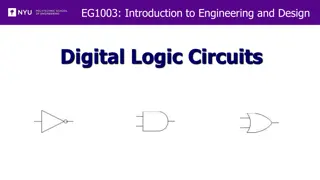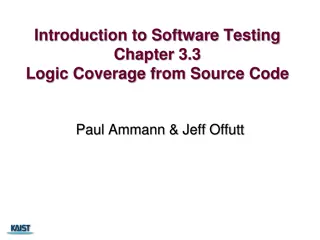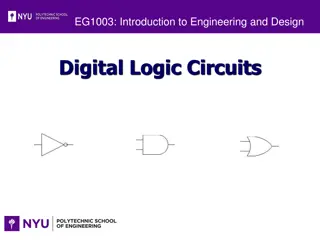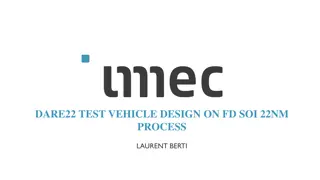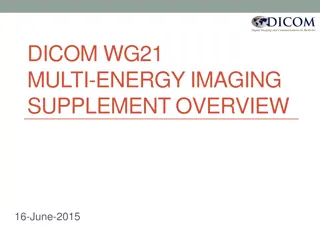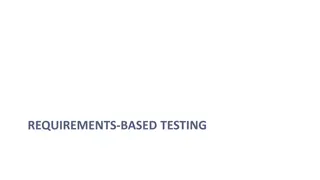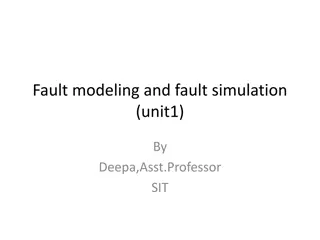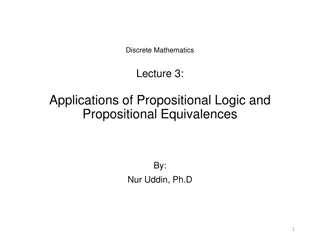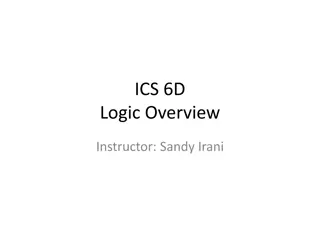Adopting Multi-Valued Logic for Reduced Pin-Count Testing
This study presented at the IEEE Latin-American Test Symposium explores the adoption of multi-valued logic (MVL) in reduced pin-count testing. The research addresses the challenges related to test cost, multi-site testing, and bandwidth mismatch in testing multiple devices simultaneously. By proposing an alternative MVL channel with 32 levels, the aim is to transfer test data efficiently with fewer test pins without compromising test speed.
- Multi-Valued Logic
- Pin-Count Testing
- IEEE Latin-American Test Symposium
- Test Cost
- Multi-Site Testing
Download Presentation

Please find below an Image/Link to download the presentation.
The content on the website is provided AS IS for your information and personal use only. It may not be sold, licensed, or shared on other websites without obtaining consent from the author. Download presentation by click this link. If you encounter any issues during the download, it is possible that the publisher has removed the file from their server.
E N D
Presentation Transcript
Adopting Multi Adopting Multi- -Valued Logic for Valued Logic for Reduced Reduced Pin Pin- -Count Testing Count Testing Baohu Li, Bei Zhang and Vishwani Agrawal Baohu Li, Bei Zhang and Vishwani Agrawal Auburn University, ECE Dept., Auburn, AL 36849, USA Auburn University, ECE Dept., Auburn, AL 36849, USA 16th 16th IEEE Latin IEEE Latin- -American Test Symposium American Test Symposium Puerto Vallarta, Mexico, March 25 Puerto Vallarta, Mexico, March 25- -27, 2015 27, 2015
Outline Motivation and problem statement Multi valued logic (MVL) signal test channel Assurance of error-free MVL test data application Experimental setup and results Conclusion and future work 3/26/2015 LATS 2015: Li et al. 2
Problem Statement and Motivation Motivation Extensively growing test cost. Multi-site test reduces test cost but requires extra test channels and fixtures for parallel testing. Reduced pin count test (RPCT) allows multi-site test though a traditional SerDes implementation may lead to longer test time. Problem statement Find a way to transfer test data with fewer test pins and without compromising test speed. 3/26/2015 LATS 2015: Li et al. 3
Background Multi-site testing and RPCT Multi-site testing aims at best utilizing the ATE resources to test many DUTs at the same time. RPCT uses fewer ATE resources to test a DUT, helping solve bandwidth mismatch and increase parallelism in multi-site testing. RPCT and SerDes A commonly implemented RPCT technology is SerDes Scan test with three pins, J. Moreau et al., ITC 09 Scan architecture using SerDes in GPU chips, A. Sang et al., VTS 11 Test Data are serially sent by ATE with fewer test channels and deserialized in DUTs. 3/26/2015 LATS 2015: Li et al. 4
Background An RPCT implementation with SerDes multi-site test but a traditional SerDes implementation requires longer test time. To send 5 bits test data, a SerDes using a single wire needs 5 cycles, compared to 1 cycle in the traditional 5-wire case (sacrifice test speed). 3/26/2015 LATS 2015: Li et al. 5
Proposed Alternative: An MVL Channel 25= 32 levels2 3/26/2015 LATS 2015: Li et al. 6
r - b i Power Consumption One binary channel 0 0 0 0 1 1 1 0 0 0 1 1 1 1 Four binary channels 0 0 1 1 1 1 1 0 0 0 0 0 1 1 1 binary pins send same data with 4x clock frequency 4 binary pins send some data A 16 lvls MVL pin send same data 4-bit SerDes channel 16-level MVL channel 3/26/2015 LATS 2015: Li et al. 7
Assurance of Error-Free MVL Test Data Application Ideal MVL signal encoding and decoding In the ideal situation, every code is correctly encoded and decoded with maximum noise margin. Compared to binary signal, the noise margin is shrunk for MVL. 3/26/2015 LATS 2015: Li et al. 8
Assuring Error-Free MVL Test Application Data converter errors Nonlinearities: DAC cannot convert a digital pattern into an analog voltage level exactly. The ranges of ADC codes are not ideal. Mismatch between DAC and ADC. Noise in channel Data converters have dynamic noise. Digital switching noise, power supply and ground noise, EMI. 3/26/2015 LATS 2015: Li et al. 9
Assuring Error-Free MVL Test Data DAC in ATE is assumed calibrated. ADC in DUT is hard to modify after fabrication. ADC nonlinearity must be calibrated. Method: calibrate ADC nonlinearity by adjusting DAC output (use finer resolution DAC) Sweep all DAC input codes and capture the decoded codes from ADC Pick the code, which is median among which are decoded as the same code, to be the DAC output for this ADC code 3/26/2015 LATS 2015: Li et al. 10
Assuring Error-Free MVL Test Data An error control technique: Noise is the major factor causing erroneous test data application after nonlinearity calibration. Solution: detect any error during test application; if error occurs, conduct retest. We compact all decoded patterns into a signature to be examined at the end of test. 3/26/2015 LATS 2015: Li et al. 11
Assuring Error-Free MVL Test Data An example Implementation with error detection. Test repeated on error. Assume 99.999% DUTs need to receive correct test data with maximum test repetitions as 4. Assume test set size is 100mb SER (symbol error rate) should be lower than 4.21e-9. 3/26/2015 LATS 2015: Li et al. 12
Experimental Setup and Results Experiment setup Use DAC AD557 and ADC AD7822 to imitate the MVL encoder and decoder Use NI ELVIS II+ prototype board system as the platform to send and receive test data DE2 FPGA board is used for imitate the core logic under test Experiments conducted Reliability Measurement: measure the SER of such converter pair in terms of noise margin with/without FPGA load Verify the nonlinearity calibration scheme Apply scan test with MVL signal 3/26/2015 LATS 2015: Li et al. 13
Experimental Setup Hardware setup Hardware system without FPGA load 3/26/2015 LATS 2015: Li et al. 14
Experimental Setup Hardware setup Hardware system with FPGA load 3/26/2015 LATS 2015: Li et al. 15
Experimental Result Reliability (SER) measurement We used voltage divider on the output of DAC to change the full scale voltage in which case the noise margin was controlled. LATS 2015: Li et al. 3/26/2015 16
Scan Test Result National Instruments ELVIS system and AD577 DAC serve as an ATE. AD7822 ADC and DE2 FPGA board implementing benchmark s298 serve as DUT. Five inputs, G0, G1, G2, scan_in1 and scan_en, are sent in MVL format, clock and reset remain binary. Test channels are reduced from 7 to 3. MVL test feasibility is established by obtaining test result identical to that of the normal 7 binary pin test. 3/26/2015 LATS 2015: Li et al. 17
Conclusion and Future Work Conclusion This is the first work to apply test data in MVL format. Reliability issues and proposed solutions are discussed in the paper. A prototype experiment proves the feasibility and verifies proposed error control solutions. Overhead remains an issue but will be helped as data converter techniques evolve. Future work Further experiments on real ATE platform. 3/26/2015 LATS 2015: Li et al. 18










